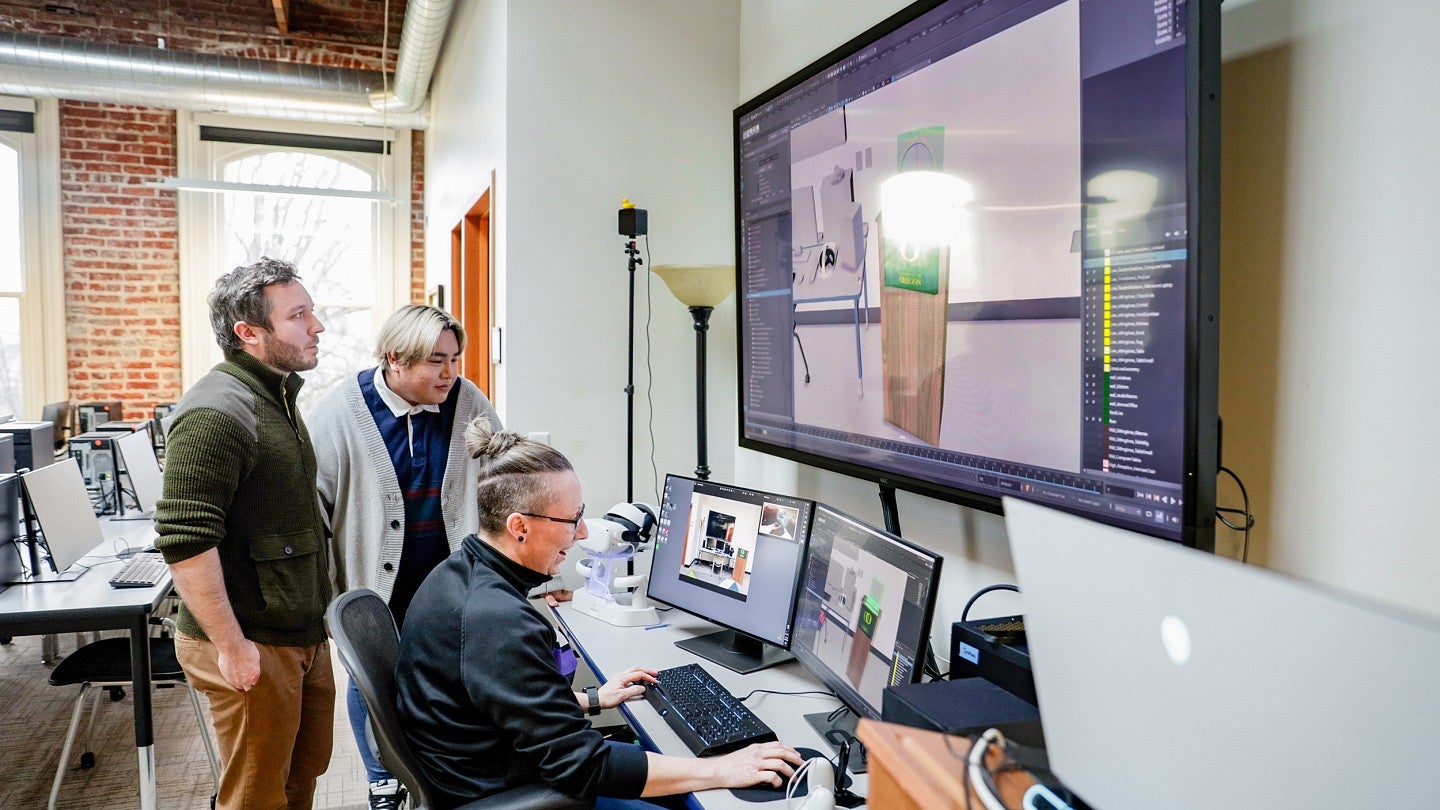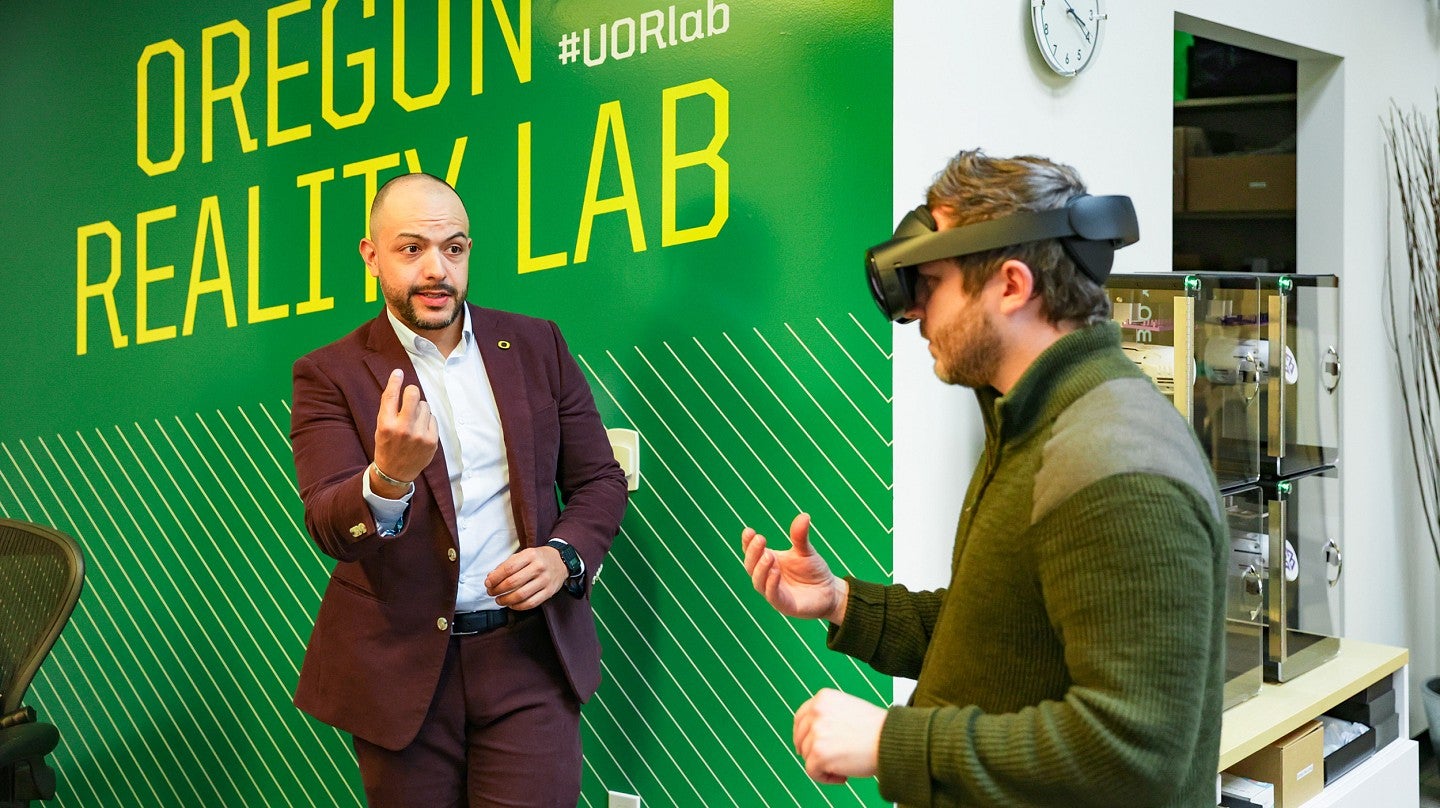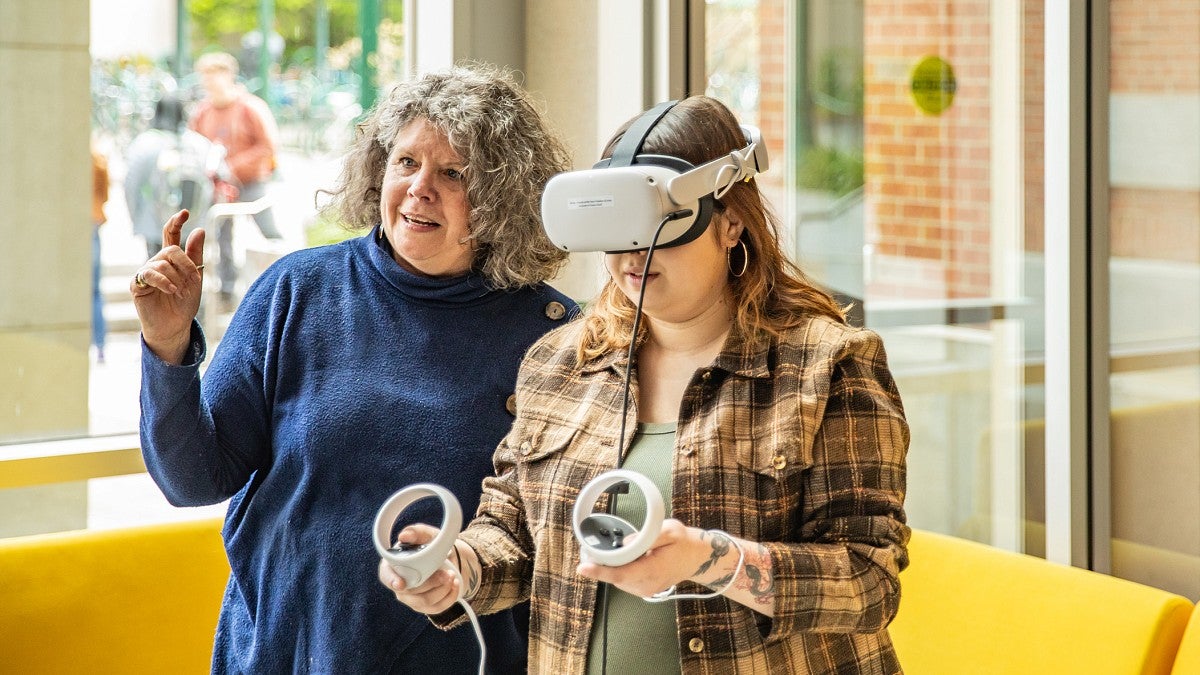
Immersive media is building a new generation of communication strategists, and the UO School of Journalism and Communication (SOJC) has launched a new master’s degree in immersive media communication to help them build a set of specialized skills.
The Immersive Media Communication Master’s program is designed to help communication professionals use immersive media strategically in their work, now and into the future. The one-year, all-online program is the first of its kind. Instructors will teach students the power of immersive media, like virtual reality (VR), augmented reality (AR) and extended reality (XR), and how to use these technologies to solve social, environmental and business problems.
Program faculty Danny Pimentel and Nikki Dunsire, and program founder and director Donna Davis are advocates for advancing skills in immersive media because, as Dunsire puts it, “the technology is coming at us like a bullet train whether we want it to or not.”
The faculty members took time to answer a series of questions to help communication professionals understand the impetus for the program and its potential to prepare them for the future of communication.
SOJC: Why did the SOJC develop this degree program?
Danny Pimentel: The emergence and convergence of various technological advancements, such as artificial intelligence and extended reality, are creating a fundamental paradigm shift in how we communicate with our audiences. Organizations have an unprecedented capacity to engage audiences in unique and experiential ways unlike what traditional media is capable of. Beyond the novelty factor, these technologies, when judiciously and strategically used, can create a meaningful impact in how audiences think, feel and behave.
Yet, despite the incredible potential of platforms like AR and VR and their increasing use in persuasive communication, communicators are still trying to figure out the basics of what these platforms do well and how they can be used strategically to achieve specific outcomes. We created this program to fill this gap and empower the next generation of communicators with the skill sets necessary to transform traditional approaches to communication and be leaders in this emerging field of immersive media.
Donna Davis: When we opened the Oregon Reality Lab (OR Lab) in 2018, we offered one course that explored virtual worlds and their potential as social and marketing environments. Since that time, our curriculum grew to include an immersive media track that also features a series of VR/AR content-building courses. This evolution was happening parallel to the popularization of the “metaverse” and the growth of Web3 technologies.
Our classes have been popular not only among SOJC students, but with graduate students from several UO Portland programs. Recognizing the opportunity to build on our success, we looked across the world at other programs that teach in the Web3 space and realized there was a huge gap in addressing these media as communication strategies. Although the industry was investing heavily in metaverse experiences and platforms, higher education was not keeping pace. We saw this as an opportunity to be the first to fill that gap.
SOJC: What can students expect from the all-online structure, the interaction with students and faculty, and the assignments?
Nikki Dunsire: They can expect a mix of both synchronous and asynchronous instruction, as well as interactive chat sessions, VR experiences as digital avatars and exposure to immersive media building tools.
DP: Students can expect a flexible yet rigorous structure that capitalizes on the benefits of remote learning, such as self-paced coursework, with thoughtful online community-building activities that go beyond just discussion boards. The faculty, such as myself, are heavily invested in this field and student success. Students can also expect to have direct access to faculty throughout their program, whether it’s for mentorship, professional development, research collaborations or other needs. Assignments are grounded in the latest industry trends and focal topics. In other words, the work students will be doing will prepare them to meaningfully contribute to a nascent and evolving industry.
DD: We have worked hard to create the best content in the best format for online learning, in partnership with UO Online. Many of the courses will be offered “on demand” asynchronously, with others being offered synchronously online. Since we’re working in immersive media and Web3, we’ll be also using many of the tools to bring our students together. For example, in the Foundations in Immersive Media class, students will have virtual “field trips” that can be done collectively or independently, and office hours will be held in the virtual world. We anticipate high levels of engagement and interaction between our students and faculty, with online collaboration at the core. It’s important for our students to feel comfortable functioning in these environments as they become leaders in this field!

SOJC: What is the biggest reason a student interested in immersive media and communication should apply for the Immersive Media Communication Master’s program?
ND: This technology is coming at us like a bullet train whether we want it to or not. Having a diverse set of voices at the table is important, and this is a discipline that is touching every industry. It’s in high demand. All of which I think makes this an appealing opportunity for students. As I say to my students, do you want to sit back and watch, or do you want your voice heard? How can we use this technology for the betterment of society?
DP: Accelerated innovation. Students in the program are going to be on a fast track to mastery of a field that is still in its infancy but is transforming every industry. With decades of combined experience in immersive media, the faculty have strived to create a program that subdues the hype and focuses on the fundamentals. Students should know that enrollment in this program means they will be able to obtain a level of mastery over the suite of immersive technologies at our disposal, and it will position them to continue to build on their newfound expertise well after the program.
DD: Anyone interested in the future of communication, whether building communities, as a content creator, or designing immersive experiences for marketing purposes, will want to complete this program! It is the only one of its kind, anywhere, and will be creating the future innovators and leaders in immersive media! While we watch the rise and fall of media hype around the metaverse and Web3, we also recognize that mass adoption is not only already here, but it’s growing. Our graduates will be strategic thinkers who will guide and advise agencies, industry and nonprofits into successful use of immersive technologies to reach audiences and help them achieve their goals.
SOJC: What does a job in immersive media look like?
DP: This can vary widely, as career paths in this field are still evolving, though there are many different roles that demand unique expertise. Whether it’s a project management position that requires a unique understanding of team composition and immersive development to see a virtual reality campaign through to launch, or a brand manager position in charge of the creation and management of AI-driven virtual influencers, the sky is the limit with regard to what students can do with their knowledge of immersive media.
DD: We’re at the dawn of an immersive media hiring spree. Companies like Nike, Disney and Gucci are hiring immersive media strategists, Web3 managers and community builders, and chief metaverse officers — job titles that didn’t exist a few years ago. This master’s program will prepare you for the communication trends of the future by teaching skills in immersive and experiential marketing strategy, user experience and design, the psychology of immersive media, and content creation for AR, VR and XR platforms.
SOJC: What fields would someone with an IMC degree go into?
DP: There are so many opportunities and pathways to success when a student has extensive experience in immersive media strategy, largely because all industries are leveraging immersive media in some form or fashion to engage with various stakeholders. Many may immediately think of the entertainment or gaming sectors, though students may easily be able to serve, for example, as a metaverse marketer for brands in the automotive industry, creating social virtual reality activations for specific car brands. Alternatively, students could also enter the retail and fashion sectors, working with product teams to create virtual try-ons via augmented reality applications like Snapchat. Every industry can effectively leverage immersive media to achieve their goals. It is only a question of what field a student wants to enter, after which they can tailor the program to give them experience to potentially enter that space.
DD: Much like traditional strategic communication, we expect graduates from this program will find their skills and expertise to be in demand across many fields. Any organization that is attempting to reach audiences for advocacy, behavior change, attitude change, sales, marketing and the many disciplines in communication can find an effective use of augmented, virtual and extended realities, much less the many other aspects of Web3 that continue to emerge. This includes agencies, businesses, advocacy organizations, governments and more. Already we see everything from museums to health care organizations to NASA to Nike finding effective uses of immersive media.
SOJC: What has been your favorite immersive project to be a part of?
ND: In 2016, I was a part of the Oregon Story Board (OSB) and Clackamas Community College (CCC) team that was one of five grant recipients for the Microsoft HoloLens Academic Research Grant. With the grant funds, two HoloLens headsets and resources from partners at Intel, Oregon Story Board created a custom classroom for teaching mixed-reality content building. Collectively, industry professionals and students learned to use software such as Unity and Maya along with Microsoft’s HoloLens, to create a holographic interactive automotive transmission that was later deployed into CCC’s Automotive Services Training classroom. Governor Kate Brown visited OSB and viewed the completed transmission though the HoloLens at the Inclusive Startup Fund media event at Oregon Story Board. I was one of three lead instructors within this studio environment. Together we helped to facilitate the success and completion of the project through the class and created a deliverable that could be a template for trade-based education worldwide.
DP: One of my more recent projects focused on Swedish-Thai musician Sirintip’s latest album “Carbon,” which centers environmental issues like climate change and biodiversity loss, and relies on innovative music production techniques like data sonofication to find new ways to engage audiences with the topics. Specifically, I worked with Sirintip to produce a branded AR experience around one of her singles on the album, “Hydrogen.” The Snapchat Lens was developed for use onsite at her concerts, wherein a user (one Hydrogen molecule) would have to get close to another person (another Hydrogen molecule) to bind together, after which they’d both bind with the song (oxygen) to create water, triggering a water visualization accompanying the music. This project leveraged various features, such as face tracking, to add an additional layer of audience engagement to the concerts while also serving as a unique way to convey the underlying message of the music.
DD: I have worked on several projects in social virtual worlds to study identity and community. One of the most gratifying experiences was working with a Parkinson’s support community for about eight years. Watching the bonds that grew among the people in that community who shared an extraordinary life bond helped me understand the potential power of these immersive worlds as a place to build social capital and genuine relationships — not to mention watching an 84-year-old woman who could log in to the virtual world and dress her avatar in a ball gown while her son would log in and put on a tuxedo and take his mother ballroom dancing. To witness that kind of joy for a woman living with limited mobility was extraordinary.

SOJC: What aspect of immersive media seems elusive now but will become commonplace in the future?
ND: Augmented wearables. They will replace the iPhone.
DP: NeRFs (neural radiance fields) are slowly becoming integrated into communication campaigns. Recently, McDonald’s used NeRF tools to turn 2D images into a fully interactive 3D scene, serving as a prime example of how Web 3.0 technologies can transform how brands engage audiences in more experiential and interactive ways. Web 3.0 represents the next iteration of the internet, one accessed through new media platforms like AR and VR. Whether it’s using mobile AR to turn product packaging into a canvas to communicate sustainability efforts, or VR to immerse audiences in a completely branded virtual world, these strategies will become increasingly feasible for organizations of all sizes and present unique opportunities for brands to allow audiences to interact with a narrative in an unstructured way.
DD: Perhaps one of the biggest challenges in immersive media now is the cost and discomfort of traditional VR headsets. The cost places it out of reach for many people, and others find the experience disorienting or uncomfortable. I do believe we will see an evolution of wearable devices that will fit more like regular glasses and will be at a price point that will make them more affordable for everyone. It’s much like the evolution of cell phones, which used to be considered a luxury for the elite but have now become ubiquitous in cultures across the world.
I know you only asked for one, but another aspect of immersive media that will become more commonplace will be accessible virtual worlds. Many of these virtual destinations currently require a very high-end computer and high-speed internet connection. I firmly believe these environments will become more accessible across many devices, both from a technological and financial perspective.
SOJC: Will the program’s classes be held in virtual reality?
DD: Although classes won’t be held entirely in virtual reality, there will be many required (and voluntary) experiences in virtual reality as part of student coursework.
SOJC: Describe the classes you teach or a couple of your favorite classes in the program.
ND: I’ll be teaching an overview to production and building course, called Building for Immersive Platforms. Students will get an introduction to the tools used for designing and building VR and AR experiences. They work with the game engine Unity to design their first interactive VR scene, AR builder Zapworks to create mobile augmented visuals, and 3D content creation software to learn the foundational skills for building real-time, ready assets. Additionally, students will explore off-the-shelf resources to get them started quickly and help them gain an understanding of the overall production pipeline for generating content for immersive spaces.
The goal of the course is to create leaders who can better communicate with the production teams they may oversee or work with when driving the production of immersive content.
DP: I will be teaching Immersive Media Psychology, which asks: What motivates people to consume different kinds of media content? More importantly, how does exposure to various forms of media influence how we think, feel and behave? This course introduces the concept of media psychology, a discipline that focuses on the interplay between messages, the platforms they are distributed through and the humans that receive them. Students will learn about various theoretical frameworks for studying why humans consume specific types of content, as well as understanding the affective, behavioral and cognitive implications of particular media messages. After completing this course, students should have the capability to think critically about how particular communications strategies may influence their target audience(s).
DD: I teach the Foundations in Immersive Media course and the Media and Communication Ethics class for this program. I have taught both of them in the Strategic Communication Master’s program and on the immersive media track for several years. The foundations class introduces students to the uses of social virtual worlds and platforms as well as AR, VR and XR through the strategic lens of communications (marketing, advertising, branding) and community building. Students begin to investigate the attributes of the technologies that create both opportunities and barriers to successful communication and follow current case examples to determine possible use cases.
The ethics class is also at the heart of this program, as we want our students and graduates to always consider the ethical use and design of immersive media. It’s important to consider not only the use but the effects of these technologies, especially when they have extraordinary power to influence people’s lives, relationships and future. Students in this class will be presented with a number of case studies where they will consider ethical decision-making. For example, this past year in strategic communication classes, we spent a great deal of time discussing AI and how it is changing our lives and our profession in dramatic ways.
Thank you to Davis, Dunsire and Pimentel for providing their perspectives on the new Immersive Media Communication Master’s program. Learn more about the program and the criteria for applying.
—By Jane Glazer, BA ’22, MA class of ’24, with additional reporting by Caitlin Crowley, class of ’24
Jane Glazer received a bachelor’s degree in journalism from University of Oregon in 2022. She joined the Multimedia Journalism Master’s program in Portland to sharpen her production and storytelling skills and plans to graduate in spring 2024.
Caitlin Crowley, class of ’24, is a student in the Multimedia Journalism Master’s program on UO’s School of Journalism and Communication’s Portland campus.
